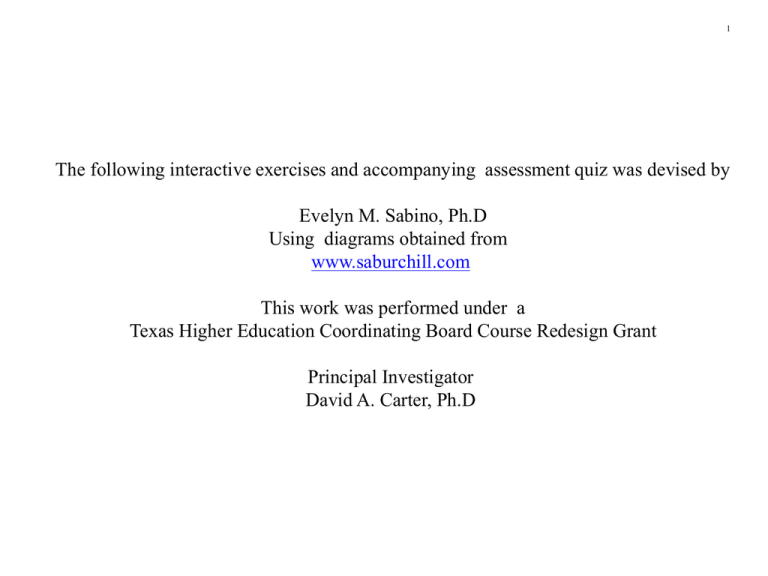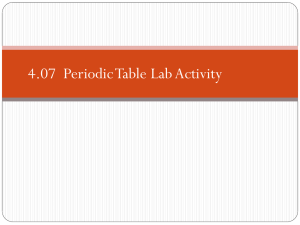Shell Diagram Exercise .
advertisement

1 The following interactive exercises and accompanying assessment quiz was devised by Evelyn M. Sabino, Ph.D Using diagrams obtained from www.saburchill.com This work was performed under a Texas Higher Education Coordinating Board Course Redesign Grant Principal Investigator David A. Carter, Ph.D 2 Keep a periodic table handy. Please down load the file and work on it at your own computer. On the following slides you will be presented with a number of diagrams of atomic species. Always in solving the requested puzzle consider the number and arrangement of electrons in each diagram and also nuclear structure. Follow the instructions in the box. When you are finished click in the text box on the slide, clear it, and then type in explanations for what you have done. When finished look at the sample answer file. All outlined boxes are instructions to students. Non outlined boxes are information for instructors. 3 The following exercise uses simple representations of the elements such as the three diagrams to the left. Please examine them. The central blue ball represents the nucleus. You will recall from your Learning Exercise that the nucleus contains the protons (different for each element) and neutrons. Here the protons are represented by a number and an upper case P, the neutrons by a number and an uppercase N. Differing from the presentation in the Learning Exercise the electrons here are represented by a small red ball with a white lower case e superimposed on the ball. The representation of electrons is in shells, represented by concentric circles, out from the nucleus. It can not be emphasized enough that this is an extremely simplified picture of the actual arrangement of electrons in an atom. In this exercise concentrate your attention on the number of electrons and their placement in shells. 4 Consider the arrangement of electrons as well as the nuclear structure. All the diagrams on this page have several similar characteristics and at the same time illustrate trends. Remember you are primarily concentrating on the electrons. Click and drag the diagrams. Arrange them so that you illustrate the trends. Type Answers Below Questions. What are the similarities you noted among members of this group? Enter where there is a space. What are the trends you observed? Be specific and detailed in your answers 6 Consider the preceding slide. Consult the periodic table. Go back and label each diagram with its atomic symbol or name. Did you observe any connections between the arrangement of the periodic table and your arrangement? Write you answer in this box and below this line . 7 Consider the arrangement of electrons as well as the nuclear structure. All the diagrams on this page have several similar characteristics and at the same time illustrate trends. Remember you are primarily concentrating on the electrons. Click and drag the diagrams. Arrange them so that you illustrate the trends. Type Answers Below Questions. What are the similarities you noted among members of this group? What are the trends you observed? Be specific and detailed in your answers 8 Consider the preceding slide. Consult the periodic table. Go back and label each diagram with its atomic symbol or name. Did you observe any connections between the arrangement of the periodic table and your arrangement? Write you answer in this box and below this line . 9 These diagrams show a trend. Focus primarily on the electrons. Click and drag the diagrams to arrange them to show the trend. Type Answers Below Questions. What are the similarities you noted among members of this group? What is the trend and what similarities do you see among the members of this group? 10 These diagrams show a trend. Focus primarily on the electrons. Click and drag the diagrams to arrange them to show the trend. Type Answers Below Questions. What are the similarities you noted among members of this group? What is the trend and what similarities do you see among the members of this group? 11 Consider the preceding two slides. Consult the periodic table. Go back and label each diagram with its atomic symbol or name. Did you observe any connections between the arrangement of the periodic table and your arrangement? Write you answer in this box and below this line. 12 Both trends observed in the previous slides are present here. Click and drag so that both are shown in columns and rows. What similarities are common to atoms in the same row? In the same column? What properties are common to all atoms? 13 Both trends observed in the previous slides are present here. Click and drag so that both are shown in columns and rows. What similarities are common to atoms in the same row? In the same column? What properties are common to all atoms? 14 Consider the preceding two slides. What about the periodic table do they illustrate? Write you answer here.







